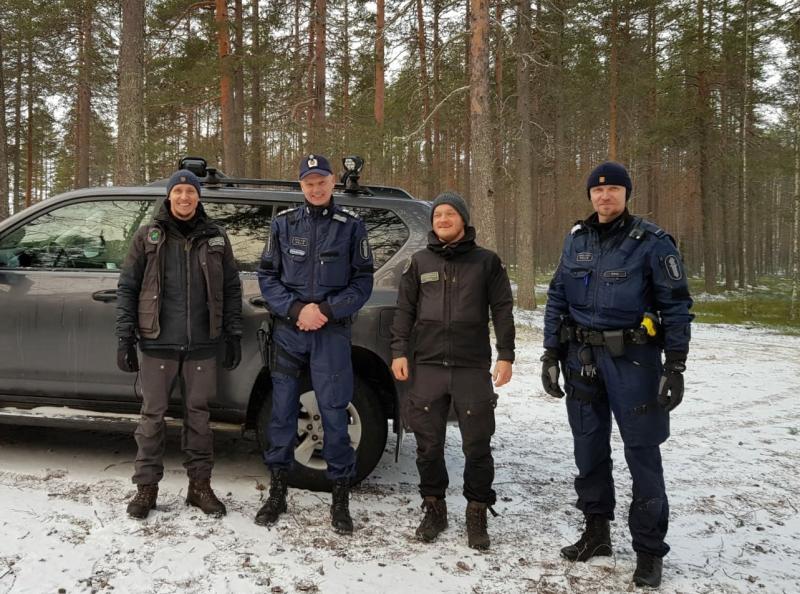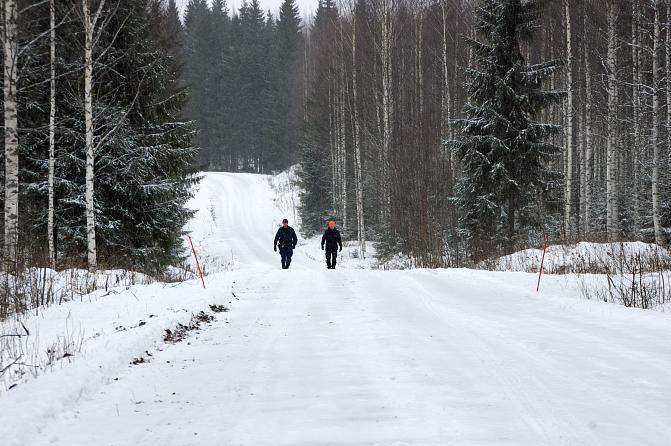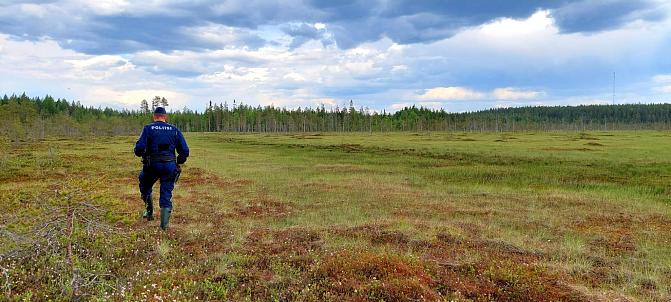Police and game warden patrol in Eastern Finland
The patrol worked in Eastern Finland until the end of 2024. Consisting of a police officer and game warden, the patrol supported local people in problems related to large carnivores and made wilderness supervision visible.
While wolves reproduce effectively, the wolf population is still growing slowly. Slow population growth cannot be explained by natural deaths, traffic accidents or legal hunting alone. According to studies, one reason for this slow growth is illegal killing. However, suspects are rarely caught. (Pohja-Mykrä & Kurki, 2013)
A likely reason for the illegal killing of wolves is a general frustration with the authorities’ inability to deal with conflicts caused by wolves and other large carnivores. For example, the police is responsible for driving away any large carnivores causing danger or killing them. In contrast, the Finnish Wildlife Agency deals with individuals that repeatedly cause losses by granting banishment permits and/or derogations.
Goal:
Preventing, uncovering and combating hunting crime, especially any illegal killing of large carnivores, and providing people with advice and support to reduce or eliminate any problematic situations related to large carnivores.
Measures:
- The police and game warden patrol provided citizens, domestic animal farmers, landowners and hikers with advice and support to resolve and reduce any problematic situations related to large carnivores.
- The patrol carried out general monitoring in sparsely populated areas in diverse ways, as well as more targeted official monitoring in areas where large carnivores had previously been killed illegally, for example.
Results
Local residents were given help to deal with large carnivores visiting their backyards
The patrol provided citizens with guidance and advice in challenges related to large carnivores and investigated locations in which a bear had damaged an apiary, for example. During the snow period, the patrol investigated reasons for wolves visiting people’s backyards and determined how to resolve such situations. In some cases, attractive sources of nutrition (such as waste or domestic animal droppings) had to be removed from yard areas; in others, the police officer monitored banishment or killing carried out as official assistance in large carnivore matters (SRVA). Based on the feedback received, citizens were satisfied with the help the patrol provided.
Increased monitoring raised the probability of uncovering hunting crime
In general monitoring, the patrol focused on the legality of hunting, the possession of firearms and the hunting methods used in legal hunting. It also monitored the appropriate transport of firearms in vehicles.
Targeted monitoring was carried out as planned and based on information in areas where wolves were known to move around, and where hunting crime had previously been discovered. A helpline was opened for the patrol through which it received many calls regarding disturbance and illegal killing of wolves. Monitoring helped increase the probability of getting caught and prevented crime. During the project, at least two new wolf territories were established in the areas in which the patrol carried out extensive monitoring.
The patrol intervened in illegal feeding sites
When carrying out general monitoring, the patrol covered known legal and illegal feeding sites for large carnivores and other wild animals. Illegal feeding in particular was found to attract large carnivores near residential areas, resulting in problems. As the project progressed, it was discovered that monitoring reduced the number of illegal feeding sites, especially in North Karelia.
Cooperation between wilderness supervision authorities developed
Cooperation between the supervisory authorities – the Police of Finland, Metsähallitus, the Finnish Border Guard and Finnish Customs – improves the efficiency of wilderness supervision. Joint activities between the authorities were developed to uncover and prevent hunting crime related to large carnivores.
Key figures
- Hunting and firearms licences inspected during monitoring activities: 1,073
- Crime report (hunting offence): 25
- Crime report (other offences): 23
- Fine (hunting offences): 22
- Fine (other offences): 34
- Fishing monitoring: 228
- Wolf DNA samples collected: 49
- Tassu sightings made: 74
Investigation of hunting offences improved
The project also developed the authorities’ capabilities. Police departments’ expertise in investigating hunting offences had decreased. If a police investigator has no link to the provisions of the Hunting Act or Decree through education, experience or recreational activities, they may find it difficult to assess whether a certain activity involves a suspected hunting offence. Challenges in police investigations have caused some people to believe the police are inactive in investigating hunting offences.
The project developed national further training for the investigation of animal welfare and hunting offences. During 2023 and 2024, some 80 people from the Police of Finland, the Finnish Border Guard and Finnish Customs, as well as prosecutors, district court judges and supervisory veterinarians, participated in the training. The Eastern Finland Police Department strengthened its investigation operations through recruitment focusing on animal welfare and hunting offences.
Scientific articles on wolf mortality and illegal killings
- Pohja-Mykrä, M., & Kurki, S. (2013). Suurpetopolitiikka kriisissä: salakaadot ja yhteisön tuki (Large carnivore policy in a crisis: illegal killing and public support). (hdl.helsinki.net)
- Suutarinen, J., & Kojola, I. (2017). Poaching regulates the legally hunted wolf population in Finland. (doi.org)
- Suutarinen, J., & Kojola, I. (2018). One way or another: predictors of wolf poaching in a legally harvested wolf population. (doi.org)
- Liberg, O., Suutarinen, J., Åkesson, M., Andrén, H., Wabakken, P., Wikenros, C., & Sand, H. (2020). Poaching-related disappearance rate of wolves in Sweden was positively related to population size and negatively to legal culling. (doi.org)





